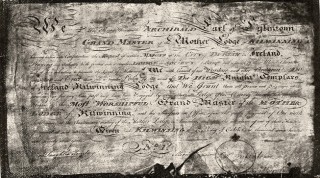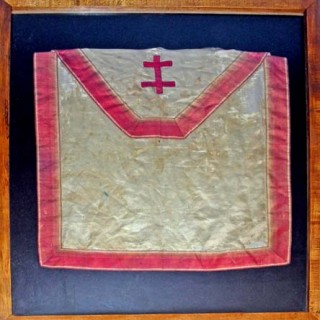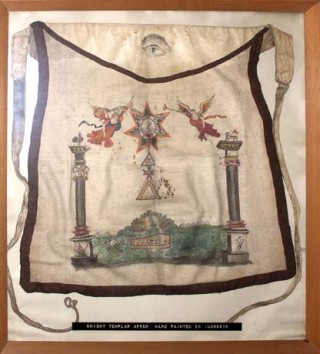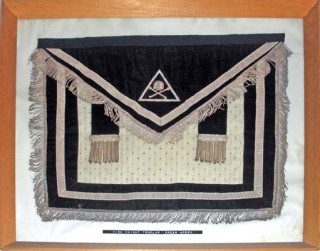Order of the Temple
Mourne Preceptory, No. 1, Cork
(High Knights Templar & Masonic Knights of Malta)
Established 1838
Meets at 27, Tuckey Street, Cork
Fourth Tuesday of January, March, September and Second Monday of November, at 8.00 pm
Chapter Contact: Rathcooney@eircom.net
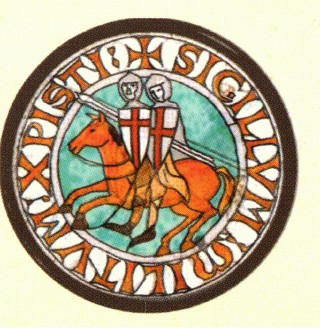 The Mourne Preceptory of High Knights Templar and Masonic Knights of Malta was established at Cork in 1838. It met at 31 Maylor Street – the premises owned by St Patrick’s Lodge No. 8, where many other lodges and royal arch chapters rented as tenants in common – until the end of 1925, whereupon it transferred to 25-27 Tuckey Street, the present venue.
The Mourne Preceptory of High Knights Templar and Masonic Knights of Malta was established at Cork in 1838. It met at 31 Maylor Street – the premises owned by St Patrick’s Lodge No. 8, where many other lodges and royal arch chapters rented as tenants in common – until the end of 1925, whereupon it transferred to 25-27 Tuckey Street, the present venue.
For a period, from 1877 until 1913, there was a second Templar meeting in Cork city, bearing the name ‘Shandon Preceptory’; it also met at 31 Maylor Street (1877-79), before transferring to 27 Tuckey Street (1880-1913).
Several Encampments of Knights Templar are known to have taken place in County Cork during the first half of the nineteenth century, as at Clonakilty (No. 385), Youghal (No. 68), and in a number of city lodges.
THE ORDER OF THE TEMPLE: A HISTORY
The following outline history of THE ORDER OF THE TEMPLE is taken from its Statutes, Laws and Regulations (1901), as well as various papers in Transactions of The Lodge of Research No. 200 (by kind permission) and the website www.irishmasonicjewels.ie
The Order of the Temple, or to give it the full title, ‘The United Religious and Military Orders of the Temple, and of St. John of Jerusalem, Palestine, Rhodes and Malta’, was in a similar position to the Royal Arch in that, even though the ‘Supreme Grand Encampment’ was established on the 25th August 1836 to govern the High Knights Templar, the degree was well known to Irish Masons as they had been working the degree for many years.
Whereas the Royal Arch degree was worked under the ‘authority’ of the Craft Warrant, the working of the High Knights Templar degree was varied. As with the Royal Arch Degree, the High Knights Templar degree was worked under the ‘authority’ of Craft Warrants; it was also worked by two Bodies, namely, ‘The High Knight Templars of Ireland, Kilwinning Lodge’, and the ‘Early Grand Encampment of Ireland’, which were independent ‘Masonic’ bodies who worked the degree with no reference to a Craft Lodge or Masonic authority and were independent of the Grand Lodge of Ireland. There were also Private Encampments (Preceptories), independent of Craft Lodges.
Craft Lodges: the oldest record of the Knights Templar Degree
The earliest recorded minute in the world of the Knights Templar degree being worked is from the minutes of the first meeting of an Irish Royal Arch Lodge meeting under the authority of the charter of St. Andrew’s Lodge No. 82 (Scottish Constitution) on the 20th August 1769. The Royal Arch Lodge was formed by Brethren from the 14th, 29th (Glittering Star No. 322) and 64th Regiments in Boston and the minutes of the first meeting record the fact that William Davis, a P.M. and Member of Lodge No. 58 in the 14th Regiment, was accepted and ‘made by receiving the four steps, that of Excellent, Super Excellent, Royal Arch and Knight Templars’. Members of an Irish Military Lodge, with a travelling Warrant, namely, Glittering Star Lodge No. 322, which is still active, conferred the Knight Templar degree.
The High Knight Templars of Ireland, Kilwinning Lodge
The first body of Knights Templar in Ireland was ‘The High Knight Templars of Ireland, Kilwinning Lodge’. On the 18th October 1779, Archibald, the 11th Earl of Eglinton, the Grand Master of Lodge Mother Kilwinning, issued a charter for a lodge in Dublin by name of ‘The High Knight Templars of Ireland Lodge, Kilwinning Lodge’.
The Mother Kilwinning lodge, in Scotland, at that time considered itself Custodian of the High Degrees, even though its own Warrant was no more than a Craft Warrant. The High Knight Templars of Ireland Lodge, Kilwinning Lodge, did not issue its first Warrant until 1805 and this appears to be as a direct result of the ‘1805 Resolutions’ of Grand Lodge.
The first warrant of ‘Kilwinning High Templar Lodge’ issued to three Brethren in Finea, County Galway in August 1805. Prior to this first Warrant ‘Kilwinning Lodge’ generally granted permission to various Lodges and individual Brethren to confer the Knight Templar degree. An example of this practice is reflected in the title page of the First Volunteer Masonic lodge No. 620 By-Laws dated 1796 which states:-
Rules and Orders of the First Volunteer Lodge of Ireland,
held in the corps of Independent Dublin Volunteers,
Excellent, Superexcellent, Royal Arch and Knights Templar,
No. 620, on the Registry of Ireland. Dublin:
Printed by Brother William Rainsford, A.D. 1786, A.L. 5786
Lodge No. 620 had no Knight Templar Warrant; the ‘Kilwinning Knights Templar Lodge’ provided it with a ‘dispensation authorizing it to confer the Knight Templar Degree’. Knights made by the Kilwinning Encampment were in general superior in social position to those ‘dubbed’ in Encampments on the Registry of The Early Grand Encampment of Ireland, such as those outlined here below.
The Early Grand Encampment of Ireland.
The Early Grand Encampment of Ireland could be said to be the predecessor to the ‘Supreme Grand Encampment’, established in 1836. The date of its formation has not been established, but it was claimed in 1805 (at the time of the ‘1805 Resolutions’), that it had been in existence for more than a hundred years; there is, however, no evidence to support this.
It is probable that the Early Grand Encampment was the one of the first established in Ireland; hence its name and assumed superiority over other Encampments (save ‘Kilwinning’). The Early Grand Encampment not only granted Charters but also exercised supervision over the Encampments on its Register.
The Early Grand Encampment appears to have commenced issuing Warrants sometime in the early 1790’s. This is suggested by the fact that Warrant No. 4 is dated 30th June 1793 and Warrant No. 9 (issued to Lodge No 451, Kingscourt, County Cavan) is dated 29th September 1796. The Early Grand Encampment can be accredited with the spread of the High Knight Templar degree, not only in Ireland, but also in Scotland, where the practice of the so-called ‘high degrees’ became so widespread in the Craft Lodges in the last decades of the eighteenth century, that the Grand Lodge of Scotland issued a directive in October 1800 ‘prohibiting and discharging its daughters to hold any meetings above the degree of Master Mason, under penalty of forfeiture of their Charter’. This ruling did not have immediate results, as many of the Lodges continued in the old ways for some years, but it did lead to many Scottish masons applying to the Early Grand Encampment of Ireland for charters – some of which still flourish under the Great Priory of Scotland.
In 1805 Grand Lodge proposed to take control of the High Knight Templar degree. As a result of the storm raised by the Early Grand Encampment, and no fewer than 400 Lodges and Encampments, the ‘1805 Resolutions’ did not, at that time, bring the High Knight Templar degree under the control of Grand Lodge. However, from what appears to be internal strife within the Early Grand Encampment, its control waned and its last act appears to have taken place on the 24th June 1826, when it renounced its rights over its Encampments in Scotland. It ceased to exist by 1836.
Encampments Independent of Craft Lodges
As can be seen from the above, some of the Warrants issued by The High Knight Templars of Ireland Lodge, Kilwinning Lodge and the Early Grand Encampment of Ireland were to Lodges, but there were many Encampments established which were not connected with Craft Lodges or under the control of any body.
The Supreme Grand Encampment
On 1st November 1787, a Bro. John Rigby, Worshipful Master of Lodge No. 620, presented a memorial to the Grand Lodge of Ireland:
‘praying that the Higher Degrees of Masonry …
shall or may be made subordinate to the Grand lodge of Ireland.’
A Committee was appointed to the subject but no action was taken. It would appear Bro. John Rigby was a member of the Kilwinning Knights Templar Lodge (and a close associate of Bro. John Fowler). In 1805 Grand Lodge resolved to constitute itself into a Grand Encampment of High Knight Templars with a view to issuing Warrants and controlling the Order. Due to the outcry raised (and the ‘Seton’ situation), nothing came of the proposals at that time; however, in 1823, the proposal was put forward again; again it came to nothing, but was not forgotten.
On 25th August 1836, a Grand Convocation of Representatives of such Irish Lodges as held Encampments of High Knight Templars was summoned to meet in the Grand Lodge Rooms, Dublin. Encampments No. 1, 5, 85, 284 and 888 were represented, and Encampments No. 331 and 957 signified their agreement to the objects of the Convocation. It was resolved to establish an Encampment of High Knights Templar under the auspices of Augustus Frederick FitzGerald, the 3rd Duke of Leinster (1791-1874), Grand Master from 1813 to 1874, as Illustrious Grand Commander (from 1838, titled Grand Master).
On 23rd February 1837, the first meeting of the Supreme Grand Encampment was held under the presidency of Augustus Frederick FitzGerald, 3rd Duke of Leinster, and since that date up to the present the ‘Order of the Temple’ has been under the direction and government of a Supreme Body. The seniority of ‘The High Knight Templars of Ireland, Kilwinning Lodge’, was recognised in that on the Registry of Preceptories it ranks only after the Grand Master’s Preceptory (1837) and is entitled ‘Kilwinning Preceptory’ (1838).
Despite the formation of the Supreme Grand Encampment in 1836 many Brethren continued with the old ways, so much so, that all Masonic Lodges were notified in the Grand Lodge Report for the half year commencing 24th June 1847 as follows:-
The Grand Lodge strictly prohibits as unlawful all assemblies of Freemasons in Ireland under any title whatever, purporting to be Masonic, not held by virtue of a Warrant or Constitution from this Grand Lodge, or from the other Masonic bodies recognised by and acting in unison with the grand Lodge of Ireland.
The Lodges are therefore desired to take notice that the Grand Lodge having granted its Warrants for BLUE MASONRY alone, cannot allow or permit them to used for any other purpose whatsoever, and Lodges wishing to work the higher degrees must have separate Warrants to authorize their proceedings, regularly signed by his Grace the Duke of Leinster as head of all grades of Masonry.
Despite the above it was still many years before the practise of Lodges working the higher degree finally came to an end. This is evidenced by a combined Royal Arch and Knight Templar certificate, which issued to Bro. William Dorman on 13th October 1866. Bro. Dorman received the said degrees in Lodge 253 on 21st June 1866, having been granted them by Lodge No. 43.
However as time went on this happened more and more infrequently, until such time as the higher degrees were completely under the control and administration of the relevant bodies. By the close of the year 1872 the title ‘Grand Encampment’ or ‘Grand Conclave’ had become ‘Great Priory’, as it is still known today.
High Knights Templar Seal 1837-69
This seal, in use from 1837 to 1869, was an equilateral triangle, each side measuring 2.2 inches, was embossed on triangular black papers slightly larger than the die. The device consists of outer and inner triangular lines, between which are the words, Supreme Grand Encampt. – of High Knights Templars – Metropolis of Ireland. Within the inner triangle are twelve small stars, arranged five to each side, and the letters ‘I.H.S.’ in the centre.
This seal, in use from 1870 to 1903, was circular in shape and 1.5 inches in diameter, embossed on red octagonal papers, cut about one-eighth inch larger than the seal on each side. The device consists of an outer and an inner circle, between which are the words, Sigillum Militae Christi in Hibernia and in the inner circle, a horse, on which are riding two Knights with their lances held horizontally. This is a very ancient device, and represents the poverty and humility of the individual members, having only one horse to serve two Knights.

